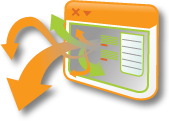“Big Data” is one of those terms that gets thrown around my workplace with reckless abandon these days. So much so, that it begins to lose it’s flavor. What does Big Data really mean? Certainly, we’ve seen a lot of lip-service paid to the sheer volume of information being generated on a daily basis (the Taming The Torrent video is a couple years old, but captures the gist of this sentiment). But, is the value of Big Data really in its “big”-ness? In many ways, the value actually comes from the opposite of big-ness, it comes from its specificity. I would argue that the value comes from the fact that it’s personal, contextual, and real-time.
This time, it’s personal…
There was a time when businesses would look at their data in aggregate. They might compare this year’s sales figures to last years, make an educated guess about how buyers were feeling, and order product accordingly. Now, each of us leaves a detailed associative trail of, not only purchasing decisions, but content, preferences, affiliations… Not everyone is as plugged-in as I am, but even if you try to keep a low profile, you leave a fairly significant digital footprint.
Now, companies can look at the data created by each of us individually, and compare them in aggregate. They can make precision decisions on how to attract, engage, and retain each one of us. They can predict our needs, sometimes better than those who know us best… The value to the customer is that your consumer experience is tailored to you (as creepy as that can be) and the value to the company is that they have a much more detailed terrain map of their customer base.
Context is king, depending on a few things…
Another unique thing about the world of today’s data, is that we have become sensors in addition to actors. When we create a bit of content or take an online action, the when and where of that interaction is also captured. Using those bits of data, a good deal of other data (weather, events, proximity to others, etc.) can also be derived. It is possible to gain insight into how much effect the sun shining has on the sentiment toward the product or service you offer. Knowing this allows companies to look ahead at a wider range of variables to predict how value can be maximized.
Turning this around, companies are finding ways to create value by making this data transparent to consumers (see Nike Fuel). Allowing people visibility into the data being captured about them allows them to better use your product or service. Products are moving from artifacts to experiences and everybody wins. Consumers get more value from their purchases, and companies get a greater understanding of their customers.
Hear and now…
In the example above of companies looking at sales data, it was almost always historical. It was last quarter’s or last year’s data that was being reviewed. Not only was it disconnected from individual customers, it was disconnected from current events. Today, the data comes in instantaneously – sales data, reactions, reviews… The company without its ear to the ground is missing out on opportunities.
The challenge here is that there is a growing expectation for some degree of reciprocity. If the customer cares enough to make a comment in the public sphere about you or your product, it is good form to recognize their comment and, if possible, react to it. This takes time and effort, but it is worth it in the end.
Parting thoughts
So, while the challenges of dealing with the torrent of data available to us remain due to the immensity of the information, the value to be gained is from understanding the uniqueness and richness of individual data streams. The central evolution that needs to be take place is to stop thinking of “people” as an entity, and start thinking of “people” as not just individuals, but as a system. You can’t expect a one-size-fits-all solution to work anymore. You also need to realize that people are connected in ways they never have been before. The way you treat each person has a ripple effect through their network of connections. That ripple effect is becoming measurable, too.
There is no denying that there is an ocean of data to deal with. The challenge becomes managing both the big aggregate shifts and the individual fluctuations. The winners will be those who can see both the waves and the tides, and can react to both effectively.


